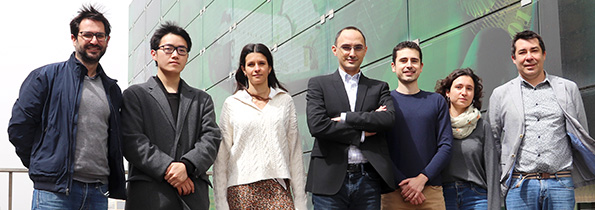Artificial intelligence and COVID-19
A study by the UPV is an international benchmark in applying AI for monitoring and managing COVID-19
[ 05/04/2022 ]
A study by researchers at the Universitat Politècnica de València (UPV), part of BDSLab-ITACA group and the Institute of Pure and Applied Mathematics (IUMPA), has become an international benchmark for the reliable use of artificial intelligence in monitoring and managing COVID-19.
In the article, published in the Journal of the American Medical Informatics Association, the team from the UPV demonstrates the limitations that the variability or heterogeneity of data may have in reliably applying artificial intelligence when it comes from multiple sources, e.g. a range of hospitals or countries. The article sets out the key aspects of potential solutions to such limitations. Furthermore, the UPV team has developed new tools based on this study to help describe and classify patients with COVID-19.
“The results of our study may, combined with these tools, assist in clinically assessing patients, and help with automated early classification by risk level both before and after hospital admission. They can even help to plan the allocation of resources, which is particularly beneficial for patients that will be admitted to the ICU,” says Carlos Sáez, a member of the BDSLab-ITACA group research team at Universitat Politècnica de València, who coordinated the study.
New predictive models
Researchers at the UPV’s BDSLab-ITACA, alongside Hospital Clínic Universitari’s INCLIVA Institute in València and Hospital 12 de Octubre’s iMas12 Institute in Madrid, have also developed an artificial intelligence model for the early prediction of mortality (within the first 30 days of admission to the emergency department), focusing principally on adults aged over 50. They have also developed a deep learning application that helps to predict severity in all age groups, with the advantage of being able to operate even with incomplete patient information, offering robust and reliable AI in the event of data quality issues.
“These predictive models can help to select the best treatment for each patient according to their mortality risk, and to plan and manage resources in cases of low availability of resources, and in a way that can withstand potential uncertainties in the available information,” says Carlos Sáez.
All of this work is part of the SUBCOVERWD-19 project, funded by the FONDO SUPERA COVID-19, promoted by CRUE Spanish Universities, Banco Santander (through Santander Universities), and the Spanish National Research Council (CSIC).
Study in Mexico
Finally, following a study of nearly 800,000 COVID-19 cases provided by the Government of Mexico and in collaboration with the Unidad Nayarit del Centro de Investigación Científica y de Educación Superior de Ensenada (México), UPV researchers have developed a new technique to investigate subphenotypes (dividing patient populations into meaningful groups) in line with clinical characteristics.
This technique, based on meta-clustering exploratory AI, can be used to automatically obtain a large number of results at different socio-demographic levels (by age group, gender, and combinations thereof), which would otherwise have to be carried out manually, involving additional work. This technique not only encourages non-discrimination, but also presents the results to the user in a detailed and intuitive manner, ready for exploration.
Applying this technique to the Mexican cases has led the UPV team to conclude that chronological age alone cannot be used as a risk factor for severity, but rather must always be accompanied by comorbidities and even habits (physiological age).
“We also observed that, under equivalent clinical conditions, women have a higher recovery rate than men and, among older people, it is those aged over 100 who recover best. And we found that there is significant variability in recovery rates between different states in Mexico and also depending on the clinical institution,” concludes Carlos Sáez.
All of the models developed by UPV researchers and their results can be found at http://covid19sdetool.upv.es and https://covidcalculator.upv.es.
Reference:
Carlos Sáez, Nekane Romero, J Alberto Conejero, Juan M García-Gómez. Potential limitations in COVID-19 machine learning due to data source variability: A case study in the nCov2019 dataset. Journal of the American Medical Informatics Association, Volume 28, Issue 2, February 2021, Pages 360–364, https://doi.org/10.1093/jamia/ocaa258
Lexin Zhou, Nekane Romero, Juan Martínez-Miranda, J Alberto Conejero, Juan M García-Gómez, Carlos Sáez. Subphenotyping of COVID-19 Patients at Preadmission To Anticipate Severity Stratification: Analysis of 778,692 Mexican Patients Using an Age-Sex Unbiased Meta-Clustering Technique. JMIR Public Health and Surveillance. 2022;8(3):e30032. https://doi.org/10.2196/30032
Outstanding news
 ARWU 2023
ARWU 2023
The Shanghai ranking reaffirms the UPV as the best polytechnic in Spain for yet another year
 Science Meets Regions CV 2023
Science Meets Regions CV 2023
The UPV and the Almussafes City Council begin a collaboration in search of solutions to maintain the automobile sector in the Valencia Region
 Scientific reference
Scientific reference
Avelino Corma, Distinguished Research Assistant at the UPV, awarded an Honorary Doctorate by the University of Huelva
 Micronanofabs NTC UPV-PERTE CHIP Conference
Micronanofabs NTC UPV-PERTE CHIP Conference
María Marced, TSMC Europe president: "The sector's future is bright, the market is expected to double by 2030"
 Goya nomination
Goya nomination
Javier Polo, who holds a degree in Audiovisual Communication from the UPV, directs the successful short documentary Una terapia de mierda
 Sant Carles Medal 2023
Sant Carles Medal 2023
The Faculty of Fine Arts of the UPV awards the Sant Carles Medal 2023 to outstanding Valencian art and culture figures







